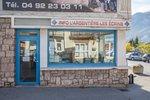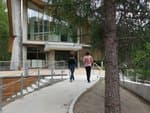THEMED PATH: The larch forest path
This downhill route offers some lovely panoramic views and varied landscapes. An itinerary punctuated with information panels on the fauna and flora, giving an insight into life on the mountain. A trail that is rich with discoveries, with a succession of points of interest. Don't forget your binoculars!
Description
Starting from the bottom terminal of the La Bergerie chairlift, take the chairlift if it is open. If it is not operating, go up the “La Bergerie” track to reach the chairlift top terminal.
- Facing away from the chairlift terminal, take the path on the right.
- Continue along the path on the left to the Combe de Narreyroux mountain stream.
- Take the path on the right which follows the mountain stream and leads back to your starting point.
- Departure : La Bergerie chairlift, Puy Saint Vincent 1,600 m
- Arrival : Puy Saint Vincent 1,600 m
- Towns crossed : L'Argentière-la-Bessée and Puy-Saint-Vincent
Altimetric profile
Recommandations
Enquire at the Puy Saint-Vincent Tourist Information Office ("Bureau d'Information Touristique") to check whether the Le Bergerie chairlift is running, so that you can reach the starting point (paying, open one morning a week). If necessary, it is possible to reach point no. 1 on foot.
Information panels are installed all along the route.
Binoculars are recommended for observing the fauna
Check weather conditions before setting off.
Rescue services contact details: Secours Montagne (Mountain Rescue): +33 (0)4 92 22 22 22 or 112
Show consideration for the work of farmers, livestock keepers and owners
Close all gates behind you
Take your litter home
Do not take shortcuts across pastureland
Information desks
23 Avenue de la République, 05120 L'Argentière-La Bessée
Vallouise Park house
, 05290 Vallouise
Information, documentation, models, exhibitions, screenings, product sales and works of the Park. Guided tours for school, reservation required. The new Park House opened in Vallouise since June 1, and offers visitors an interactive permanent exhibition inviting to explore the area and its heritage. A temporary exhibition space will allow a renewed offer. Finally, the device is completed by an audiovisual room to organize screenings and conferences Free admission. All animations of the Park are free unless otherwise stated.
Transport
Public transport >> www.pacamobilite.fr
Consider car-sharing >> www.blablacar.fr
For more information, ask at the Tourist Information Office nearest to the trail starting point.
Access and parking
14.7 km from L'Argentière-La Bessée, take the D994E, the D4 and the D804.
Sensitive areas
Black grouse - winter
- Impacted practices:
- , Land
- Sensitivity periods:
- JanFebMarAprDec
- Contact:
- Parc National des Ecrins
Thierry Maillet : thierry.maillet@ecrins-parcnational.fr
Membre de l'Observatoire des Galliformes de montagne
Virginie Dos Santos : ogm.vds@gmail.com
Blandine Amblard : ogm.amblard@gmail.com
Golden eagle
- Impacted practices:
- Aerial, , Vertical
- Sensitivity periods:
- JanFebMarAprMayJunJulAug
- Contact:
- Parc National des Écrins
Julien Charron
julien.charron@ecrins-parcnational.fr
6 points of interest
 Fauna
FaunaThe ptarmigan and the mountain hare
The rock ptarmigan, a member of the grouse family, and the mountain hare are both perfectly adapted to high-altitude life. Among other adaptations, they turn white in winter in order to escape the attention of predators, and they are grey-brown in summer. In addition, their feet are covered with feathers or fur, and act as snowshoes when moving over snow. They are particularly threatened by the increasingly early arrival of the flocks in the alpine pastures, the boom in winter tourism and climate change.
 Fauna
FaunaThe wheatear
This bird is common in the alpine pastures and can be recognised by its grey back, its pale underside, its white rump, its white tail the shape of an inverted black "T" and by a black stripe over its eye. During the mating season, the male's underside is pinkish. Perched on a large rock, he utters a loud «uit uit» alarm call, which gives his presence away. A migratory bird, he arrives from Africa in April and flies south again in September.
 Flora
FloraThe larch forest
The symbol of the Southern Alps, this softwood tree loses its leaves in winter. Perfect adaptation to winters in the high mountains: being leafless, the branches are better able to withstand the weight of the snow. Arranged in little clusters, the leaves are a soft green in the spring and golden yellow in the autumn. It is a pioneer species which needs light in order to grow. It provides mankind with a source of pasture for the flocks and a strong and rot-proof construction material. Fauna
FaunaThe red wood ant
The nest of the red wood ant is made from conifer needles, dry grass and earth. It is home to between 200,000 and 500,000 ants! It gives of an odour of vinegar, due to the formic acid, a substance sprayed by the ants as a defensive mechanism. Inside the nest, the worker ants each have their own task. In early summer, a large number of winged ants fly from the nest: these are males who will only live for a few days, enough time to reproduce, and a few new queens.
 Flora
FloraThe "megaphorb"
The "megaphorb" is a combination of mega-plants which establish themselves in places where the soil is permanently damp, deep and nutrient-rich. The adenostyles alliariae, the alpine sow-thistle, the masterwort or false benjoin and the tansy-leaved rocket are among them. Vernacular heritage
Vernacular heritageThe mountain habitat
The houses here were once built with local materials: stone and larch wood. They are roofed with shingles rather than the lauze (flat stone) commonly seen in other mountain regions. The hamlet of Narreyroux was a high mountain hamlet within the the municipality of Puy-Saint-Vincent. In fact, one of the chalets is still used as a shepherd's cabin, before the flock moves up the valley floor where the Grands Plans shepherd's cabin is situated.
Accessibility
Source

Report a problem or an error
If you have found an error on this page or if you have noticed any problems during your hike, please report them to us here:


